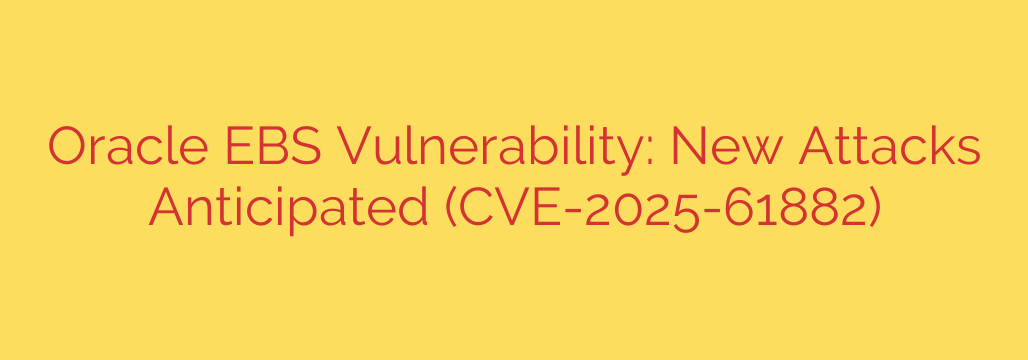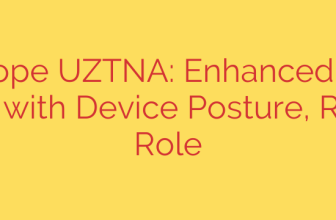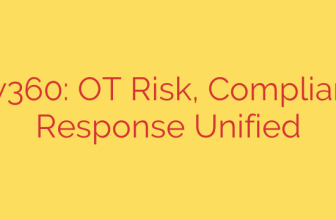
Critical Oracle EBS Vulnerability (CVE-2025-61882): Urgent Patching Required to Prevent Attacks
A newly disclosed, critical vulnerability in Oracle E-Business Suite (EBS), identified as CVE-2025-61882, is placing organizations at immediate risk of cyberattack. Security researchers are warning that active exploitation is highly anticipated, making it imperative for system administrators to take immediate action. This flaw could allow unauthenticated attackers to gain complete control over affected systems, jeopardizing sensitive corporate data and mission-critical operations.
Oracle EBS is the backbone for countless organizations, managing everything from financials and human resources to supply chain logistics. A compromise of this system is not just an IT problem—it’s a fundamental business risk that can lead to catastrophic consequences.
Understanding the Threat: What is CVE-2025-61882?
This vulnerability resides within a core web-facing component of the Oracle E-Business Suite, meaning it can be targeted remotely over the internet without requiring valid user credentials. The flaw allows for remote code execution (RCE), which is one of the most severe types of security vulnerabilities.
In simple terms, an attacker can exploit this weakness to run their own code on your server. This effectively gives attackers the keys to the kingdom, enabling them to take complete control of the affected system. Once they have this level of access, they can steal, modify, or delete data, install malware like ransomware, and pivot to attack other systems within your network.
The Potential Impact on Your Business
The consequences of a successful exploit against CVE-2025-61882 are severe and far-reaching. Organizations that fail to patch this vulnerability expose themselves to a range of devastating outcomes:
- Massive Data Breaches: Attackers can gain access to highly sensitive information, including financial records, employee personal data (PII), proprietary business information, and customer details.
- Complete Business Disruption: An attacker could shut down your EBS instance, grinding critical business functions like payroll, accounting, and manufacturing to a halt.
- Financial Loss: The costs associated with a breach are enormous, including remediation expenses, regulatory fines, legal fees, and the long-term impact of reputational damage.
- Ransomware Deployment: Compromised EBS servers are a prime target for ransomware gangs, who can encrypt your most valuable data and demand a hefty ransom for its return.
- Compliance Violations: A data breach resulting from an unpatched system can lead to severe penalties under regulations like GDPR, CCPA, and HIPAA.
Given that Oracle EBS often manages the most sensitive data within an organization, the consequences of a successful exploit cannot be overstated.
Actionable Steps: How to Secure Your Oracle EBS Systems
Protecting your organization requires a swift and decisive response. Waiting is not an option, as threat actors are already beginning to scan for vulnerable systems. Follow these essential security steps immediately:
Apply the Oracle Patch Immediately: Oracle has released a security patch as part of its Critical Patch Update (CPU) program. This is the single most important step you can take. Prioritize the deployment of this patch across all of your production, development, and test environments.
Verify Patch Installation: Do not assume a deployment was successful. After applying the patch, verify that it has been installed correctly and that the vulnerability is fully remediated.
Review and Restrict Access: As a best practice, ensure that your Oracle EBS instance is not unnecessarily exposed to the public internet. Limit access to trusted IP addresses and place the system behind a properly configured Web Application Firewall (WAF) that can help block malicious exploit attempts.
Monitor for Suspicious Activity: Closely monitor server logs, network traffic, and application activity for any unusual behavior or indicators of compromise (IOCs). A robust monitoring and alerting system can help you detect an attack in its early stages. If you suspect a compromise, immediately activate your incident response plan.
Implement Compensating Controls: If you are absolutely unable to patch immediately, implement compensating controls as a temporary measure. This could include using a WAF with specific rules to block exploit patterns or severely restricting all external access to the system until patching is complete. However, these are temporary fixes and not a substitute for applying the official patch.
The window of opportunity to act is closing quickly. The period between a patch release and widespread exploitation is often measured in hours or days, not weeks. Protecting your critical business infrastructure from CVE-2025-61882 requires treating this threat with the urgency it deserves. Update your systems now to safeguard your data and your business.
Source: https://www.helpnetsecurity.com/2025/10/07/leaked-oracle-ebs-exploit-attacks-cve-2025-61882/








